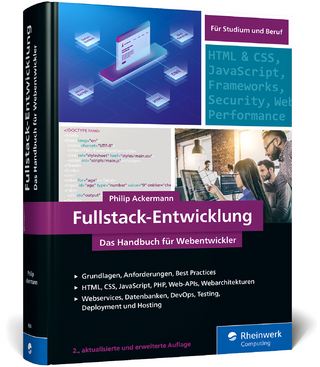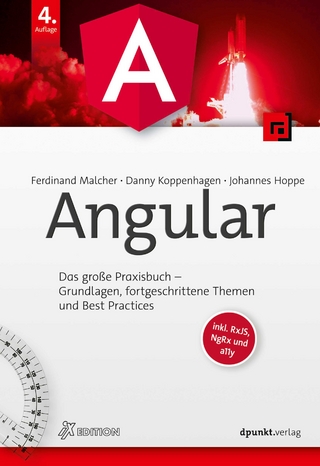
Sams Teach Yourself Object-Oriented Programming with Visual Basic.NET in 21 Days
Sams Publishing (Verlag)
978-0-672-32149-8 (ISBN)
- Titel ist leider vergriffen;
keine Neuauflage - Artikel merken
This book is focused on "getting the concepts" as well as teaching how to apply OOP concepts in the new version of Visual Basic. The reader is not expected to have any mastery of a given OOP language. In fact, the stress of having to learn the syntax of an OOP language, without first having a strong conceptual foundation about the OOP paradigm, often prevents the programmer from doing effective Object Oriented Programming at the language level. However, a beginner¿s knowledge of the Visual Basic language is a definite plus.
Richard J. Simon is cofounder of MillenniSoft, Inc., a software development and consulting company that specializes in custom application development with the latest technologies for Windows and the Internet. Before starting MillenniSoft, Richard was a CTO for more than eight years in a software development company that specialized in client/server development with n-tier technology. In 1985, Richard started consulting and developing custom PC software applications. By 1989, he was developing Windows applications for some of the largest Fortune 500 companies in the United States. Richard has always been on the cutting edge of technology and spends his time researching and developing new technologies to bring to market. He has authored Windows 2000 APISuperBible (Sams Publishing, ISBN: 0-672-31933-0) and tech edited several books on Windows development. Ken Cox is a technical writer and Web developer in Toronto. A Microsoft Most Valuable Professional (MVP), Ken is a frequent contributor to computer books and magazines dealing with Microsoft technologies. During six years with Nortel Networks, he was the senior technical designer on the documentation department's multimedia team. Ken's technical writing has won several awards from the Society for Technical Communication. Before turning his interests to computers and things high-tech, Ken had a successful career as a broadcast journalist in Toronto and Quebec City for Canada's top radio stations and news networks. Leslie Koorhan is a certified trainer and developer in New Jersey. He works with Microsoft SQL Server and Microsoft Visual Studio. Leslie is a Microsoft Certified Trainer, a Microsoft Certified Solution Developer (MCSD), a Microsoft Certified Systems Engineer (MCSE) using Windows NT 4.0, and a Microsoft Certified Database Administrator (MCDBA). He has been a computer professional for many years and has worked in the PC arena for nearly two decades. As such, he has used many development products over the years; most recently Visual Basic and has been involved in Internet technologies such as ASP, XML, and XSLT. Leslie has done courseware design, written a book on Access, and written articles for several publications. He can be reached at lkoorhan@earthlink.net Ken and Leslie served as both contributors and technical editors for this book.
(NOTE: Each chapter concludes with a Summary, Q&A, and Workshop.)
Introduction.
How This Book Is Organized. Conventions Used in This Book.
WEEK 1. AT A GLANCE.
Day 1. Object-Oriented Programming 101: Making the Task Application.
Creating a Project. Defining the SimpleMsg Object. Creating a SmartMsg Class. Building the MsgReader Object. Putting It All Together.
Day 2. Learning to Speak OOP.
Objects. Classes. Members and Scope. Properties. Methods and Behavior. Events and Delegates. Constructors. Destructors. Interfaces.
Day 3. Enclosing Features and Data in Objects.
Designing a Public Class Interface. Protecting Class Members. Defining Private Class Members. Designing Objects Using Encapsulation.
Day 4. Making New Objects by Extending Existing Objects.
Understanding Inheritance. Fine-tuning the Class. Using Inheritance in Visual Basic .NET.
Day 5. Giving Objects Polymorphic Behavior.
Understanding the Benefits of Polymorphism. Using Polymorphism in Visual Basic .NET.
Day 6. Building Complex Objects by Combining Objects.
Understanding Composition Versus Inheritance. Designing Objects Using Composition.
Day 7. Getting to Know the Visual Basic .NET Programming Environment.
Working in the Microsoft .NET Framework. Working with the Visual Basic .NET IDE. Running and Debugging Applications. Using Online Help.
Appendix Bonus Project. Putting on the Dog…With Class.
Peeking Ahead at the Result. Creating the Base Class. Using the Base Class. Developing the Doggone Logic.
Week 1. In Review.
WEEK 2. AT A GLANCE.
Day 8. Working with Visual Basic .NET Data Types.
Exploring Visual Basic .NET's Array of Data Types.
Day 9. Organizing Classes into Groups.
Understanding Namespaces.
Day 10. Creating a User Interface.
Choosing the Form for the Task. Using Windows Forms. Using Web Forms.
Day 11. Creating and Using Components.
Creating Visual Basic .NET Component Classes. Programming Classes for Runtime.
Day 12. Building Web Applications.
Object-Oriented ASP.NET with Visual Basic .NET. Understanding Web Services.
Day 13. Deploying Visual Basic .NET Projects.
Understanding Assemblies. Using Assemblies. Deploying Assemblies.
Day 14. Working with Object Interfaces.
Revisiting Interfaces and OOP. Creating the Interface Contract. Programming for Interfaces. Implementing Interfaces. Using Interfaces as Callbacks.
Week 2. In Review.
WEEK 3. AT A GLANCE.
Day 15. Handling Events, Messages, and Notifications.
Revisiting Events and Delegates. Using Asynchronous Operations with Events. Creating and Using Custom Events and Delegates. Using Events for Notification.
Day 16. Gracefully Capturing Errors.
Understanding Structured Exception Handling. Creating and Using Custom Exception Classes.
Day 17. Developing and Using Remote Objects.
Understanding the Fundamentals of Remote Objects. Choosing Between Copies and References. Using Channels for Communication. Building a Host and Client for TCP Connections.
Day 18. Designing a Project Management Application.
Meeting with the Client. Designing with the Requirements.
Day 19. Creating the Project Management Application.
Creating a Class Module. Creating the Interface. Creating Classes.
Day 20. Adding Features to the Application.
Designing a Visual Class. Creating a Visual Class. Creating the Forms.
Day 21. Enhancing the Application's Features.
Persisting Data. Introducing XML. Understanding the Document Object Model and XPath. Coding the Class Module. Seeing the Data. The Product, Project, and ProjectItems Classes.
Week 3. In Review.
Appendix A. Answers to Quizzes.
Day 1, “Object-Oriented Programming 101: Making the Task Application”. Day 2, “Learning to Speak OOP”. Day 3, “Enclosing Features and Data in Objects”. Day 4, “Making New Objects by Extending Existing Objects”. Day 5, “Giving Objects Polymorphic Behavior”. Day 6, “Building Complex Objects by Combining Objects”. Day 7, “Getting to Know the Visual Basic .NET Programming Environment”. Day 8, “Working with Visual Basic .NET Data Types”. Day 9, “Organizing Classes into Groups”. Day 10, “Creating a User Interface”. Day 11, “Creating and Using Components”. Day 12, “Building Web Applications”. Day 13, “Deploying Visual Basic .NET Projects”. Day 14, “Working with Object Interfaces”. Day 15, “Handling Events, Messages, and Notifications”. Day 16, “Gracefully Capturing Errors”. Day 17, “Developing and Using Remote Objects”. Day 18, “Designing a Project Management Application”. Day 19, “Creating the Project Management Application”. Day 20 “Adding Features to the Application”. Day 21 “Enhancing the Application's Features”.
Index.
| Erscheint lt. Verlag | 26.2.2002 |
|---|---|
| Verlagsort | Indianapolis |
| Sprache | englisch |
| Maße | 186 x 231 mm |
| Gewicht | 701 g |
| Themenwelt | Mathematik / Informatik ► Informatik ► Programmiersprachen / -werkzeuge |
| ISBN-10 | 0-672-32149-1 / 0672321491 |
| ISBN-13 | 978-0-672-32149-8 / 9780672321498 |
| Zustand | Neuware |
| Haben Sie eine Frage zum Produkt? |
aus dem Bereich


